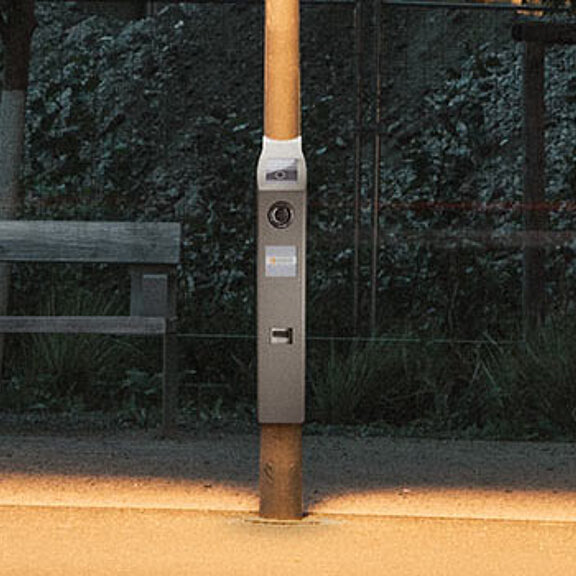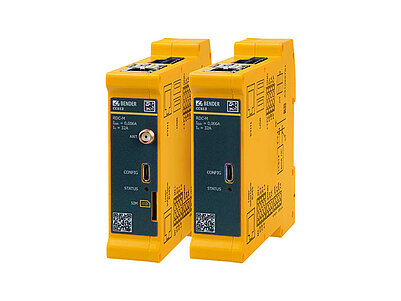

The concept, of charging electric cars directly off roadside lighting (street lamps), is as simple as it is smart. Requests for the street lamp variant of the ‘Berlin’ charging point are coming in thick and fast.
“The integration of power sockets in existing infrastructure like street lamps [...]” is a “[...] fundamentally available technical solution”. This prompts the authors of Germany’s nationwide call for financial funding to set up a charging infrastructure as part of the ‘Immediate Clean Air Programme 2017 to 2020’ [Sofortprogramm Saubere Luft 2017 bis 2020] on 4 January this year. The Ministry employees are also thinking along the right lines with their depiction of ‘Street lamp charging’ as a low-cost charging infrastructure, and they further reason: “At present, affordable charging facilities are absent in many applications, at places where people park for extended periods and could charge their vehicles, for example overnight. This prevents those affected from being able to consider electric vehicles as a genuine alternative form of mobility. One example of this would be users who either do not have access to a fixed parking space or who are not able to equip the one they have with a charging point”.
The Berlin start-up and partner of Bender GmbH & Co. KG, ebee smart technologies GmbH, would have to formulate its founding myth in a similar way. In fact, the vision right from day one of this manufacturer of charging infrastructure, founded back in 2011, was to use the electrical infrastructure already in the public domain for the charging of electric vehicles. What has emerged from this is the ‘Berlin’ charging point, developed and sold by ebee. Its slimline hardware enables it to be fitted to street lamps quickly and easily, as well as to walls, pillars or to ‘urban furniture’.
“Just drill three holes in each mast and it takes an electrician just thirty minutes to install” – according to ebee CEO Robert Weyrauch, that is all that is needed to connect the ‘Berlin’ charging point to a street lamp. The minimum requirements for installation, according to ebee, are a minimum mast diameter of 115 mm and a minimum mast wall thickness of about 5 mm. In terms of electrical supply lines, a lamp connection phase should be able to support an additional burden of at least 10 A: This equates to a minimum charging scenario of 2.3 kW. Provided that a 3-phase connection exists, it is possible to increase this scenario to 22 kW. Finally, and above all, it must be possible to park directly beside a street lamp. If there is a footpath between parking space and street lamp over which the charging cable would have to be routed, the ebee team considers that to be one of the few ‘genuine’ reasons to obstruct finalisation of this project.
Nonetheless, some mayors and municipal utility providers still have some reservations about the decision to go ahead with ‘street lamp charging’ in their communities. These are founded upon the allegedly excessively long charging times involved at street lamps due to their lower charging power. Furthermore, a few view the problem in terms of the absence of separate power accountability, or in the insufficient cross section of power lines in the street lighting grid. Often, the question arises as to where the electrical power should come from for charging points during daylight hours, while the lighting is switched off. “In most cases, it is usually possible to clear away the technical reservations in the course of the initial meeting with a customer”, adds Robert Weyrauch. Since the changeover of public lighting to LED technology, there is usually sufficient surplus current in the street lamps. Due to its ‘close-to-TAB’ concept, the ‘Berlin’ charging point also makes it possible to set up a public meter station together with electronic, MID-calibrated domestic meters and intelligent data communication. In the case of thin cross sections of electrical power lines, charge point performance can be restricted by the intelligent charge controller.
Ultimately, the day-night problem simply does not arise in the case of a distribution network, given that street lamps are connected separately to a main line, which means that even during daylight hours, there is sufficient electricity available up to the cable transition point. In the case of a lighting grid, i.e. where the switching of lights down complete streets does not take place until dusk, existing phases can be switched over to continuous current. This means that electrical power is being supplied to street lamp charging points during daylight hours. The disconnectable circuit between lighting and charging point is controlled by ripple control and/or by an interface on the charging point controller.
The true benefits of charging from a street lamp really come into their own in the public precincts in towns and cities - specifically wherever a shortage of private garages oblige people to park beside the kerb, and in roadside parking bays. This is where the cultural mobility side of ‘street lamp charging’ really gains in significance. The fear that the 2.3 kW to 7 kW charging power envisaged for single-phase street lamp charging points may be insufficient for users can be countered by an old saying about petrol stations, ‘seek, fill, drive’. In contrast, street lamp charging points are a cost-efficient way of delivering widespread availability of charging points within the public domain. This dispenses with the need for ‘seeking’. Given that most drivers only cover short distances most of the time, there is no need for full charging - topping up is all that is involved. Finally, many parking situations, for example at a workplace or during the night, involve vehicles being parked for long periods. At the end of which, batteries can be fully charged, since even a 3.6 kW street lamp charging point delivers an hourly charge equivalent to about 25 kilometres of driving.
The future of street lamp charging is starting to gain headway. For example, ebee exclusively supplies the winner of the Berlin tender, Allego, with lantern charging points for public operation. Street lamp pilot projects based on ebee’s ‘Berlin’ charging point have been implemented in Bottrop, Aachen Hanover and Cologne. In November 2017, the power grid operator E.DIS inaugurated its first ‘Berlin’ street lamp charging point in the Brandenburg district of Grossbeeren. To date, a further three ebee-Bender customer companies have achieved success with domestic and international sales of their own street lamp charging point solutions, each one based on the CC612 charge controller.
To an increasing extent, infrastructure operators are starting to become aware of the potential of charging at street lamps. Now car drivers are being asked to become inspired in future by the ebee motto for charging in public precincts:
“We don't drive to charge. We charge while parked (beside a street lamp)”.
Dipl. Pol. Peter Wilhelm, ebee smart technologies GmbH, Berlin
| Name | Category | Size | Language | Timestamp | D-/B-Number |
|---|---|---|---|---|---|
| Charging Electric Vehicles - Protection Against Electric Shock by DC Fault Current Sensor Units | Technical article | 931.2 KB | EN | 2019/05/1313.05.2019 | |
| Calibration law | Flyer | 146.5 KB | EN | 2019/06/0505.06.2019 |
Products

Charge controller in enclosure for DIN rail mounting for classic integration with standard components

Charge controller in enclosure for DIN rail mounting for classic integration with standard components